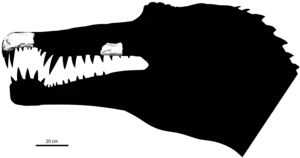Oxalaia facts for kids
Quick facts for kids Oxalaia |
|
|---|---|
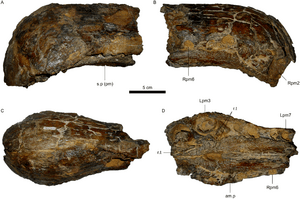 |
|
| Holotype snout in multiple views | |
| Scientific classification |
|
| Kingdom: | Animalia |
| Phylum: | Chordata |
| Clade: | Dinosauria |
| Clade: | Saurischia |
| Clade: | Theropoda |
| Family: | †Spinosauridae |
| Subfamily: | †Spinosaurinae |
| Genus: | †Oxalaia Kellner et al., 2011 |
| Type species | |
| Oxalaia quilombensis Kellner et al., 2011
|
|
| Synonyms | |
|
|
Oxalaia was a large predatory dinosaur. It lived during the Upper Cretaceous of what is now Brazil, sometime between 100.5 to 93.9 million years ago. Oxalaia is known only from two bones of the skull, which were discovered in 1999. The animal was named in 2011 by a group of Brazilian palaeontologists.
It was a member of the Spinosauridae family, a group of crocodile-like theropod dinosaurs. Like other spinosaurids, Oxalaia had a long nose or snout with jaws and teeth shaped to feed on fish. Oxalaia's habitat was tropical, an area of large forests around which were dry deserts. Oxalaia shared this environment with many other animals, most of which are also known from other Cretaceous fossils discovered in Africa.
Contents
Discovery and naming
In 1999, two fossil bones of Oxalaia were found in rocks on an island in the Northeast Region of Brazil. This part of the island gets covered up by the sea at high tide. Because of the action of the waves which cause erosion, the fossils were almost lost. Hundreds of other fossil teeth were also found at the same place.
The full name of the dinosaur is Oxalaia quilombensis. The animal was named by Brazilian palaeontologists Alexander Kellner, Elaine Machado, Sergio Azevedo, Deise Henriques, and Luciana Carvalho. The first part of the dinosaur's name (the genus) comes from an African god. The second part of the name (the species) comes from the quilombos, a group of Brazilian towns.
In 2011 the discovery of Oxalaia was presented at the Brazilian Academy of Sciences. Machado said that people are interested in spinosaurids: because of how different they are from other carnivorous dinosaurs, and because they are known by the public through the Jurassic Park movies.
Only two pieces of bone are known from Oxalaia. The first is the tip of its snout, called the premaxilla bone. The second is a piece of its left maxilla, or main upper jaw bone. The two pieces were put on display in the National Museum of Brazil in 2011. The museum was burnt down in a large fire in 2018, and the Oxalaia fossils may have been destroyed.
Oxalaia is the third spinosaurid named from Brazil so far. The other two are Irritator and Angaturama (which might be the same animal as Irritator). These two animals are known from another part of Brazil, and lived nine to six million years before Oxalaia.
Description

To estimate its size, Oxalaia's skull bones were compared with those of its close relative, Spinosaurus. Oxalaia was probably 12 to 14 metres (39 to 46 feet) long, and likely weighed 5 to 7 tonnes (4.9 to 6.9 long tons; 5.5 to 7.7 short tons). This makes it the largest known carnivorous dinosaur from Brazil.
The tip of Oxalaia's snout, called the premaxilla, was 201 millimetres (7.9 inches) long. Oxalaia's complete skull was probably 1.35 metres (4 feet 5 inches) long. This is shorter than the skull of Spinosaurus, which was 1.75 metres (69 in) long.

The front of Oxalaia's upper jaw was spoon-shaped, or larger at its front end than at its rear end. The bottom of the snout tip was curved inwards. This shape would have joined with the lower jaw, or mandible, which was also spoon-shaped. The roof of Oxalaia's mouth had a very complex and bony surface, called a secondary palate. This structure made the upper jaw more sturdy, so it would bend less when feeding. The fossil snout preserves broad and deep holes. These probably contained blood vessels and nerves.
The snout of Oxalaia had seven tooth sockets on each side. It had one tooth in each socket, and there were two teeth underneath to replace it if it fell out. This feature is common in sharks, but not in most theropod dinosaurs. Oxalaia's teeth were also oval in cross section, instead of flattened somewhat sideways like in most theropods.
Classification
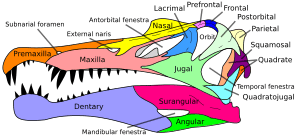
Oxalaia is more closely related to the African than Brazilian members of its family. Oxalaia, Irritator, Angaturama, Ichthyovenator, and Spinosaurus are the only known dinosaurs from their clade that don't have knife-like (or serrated) teeth. This places them in their own subfamily, called the Spinosaurinae.
Oxalaia can be separated from Spinosaurus by differences between their jaw bones. For example: Oxalaia had a rounder snout, and more closely spaced teeth than Spinosaurus. Oxalaia's two replacement teeth per socket, and less smooth secondary palate, also make it unique among the other known spinosaurs.
The cladogram below shows Oxalaia's relationship with other spinosaurids. It is from a study by Marcos Sales and Cesar Schultz:
| Spinosauridae |
|
||||||||||||||||||||||||
Palaeobiology
Diet and feeding
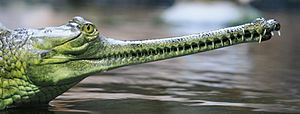
Spinosaurids likely spent most of their time near or in water, feeding mostly on aquatic animals like fish. This way, they would avoid competing with other large predatory dinosaurs. Fossil evidence shows that spinosaurs sometimes also ate pterosaurs and small dinosaurs.
The cone-shaped teeth of Oxalaia were built for impaling prey, instead of cutting flesh like those of most theropod dinosaurs. Oxalaia's nostrils were placed far back on the head. This was probably to avoid water getting inside its nostrils when fishing. Both of these features were unique to spinosaurid dinosaurs, and were useful for catching and feeding on fish. The spoon-shaped front jaws and piercing teeth of spinosaurs worked as an efficient fish trap. This trait is also seen in the Indian gharial—the most fish-eating of modern crocodilians.
Habitat
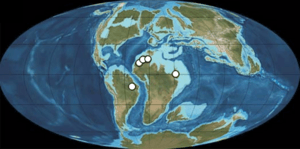
Oxalaia is known from the Alcântara Formation, a geological formation in northeastern Brazil. This formation dates to the Upper Cretaceous Period, sometime between 100.5 to 93.9 million years ago. Back then, the environment of the formation had a wet climate. There were large tropical forests made of plants like conifer trees, ferns, and horsetails. These forests were surrounded by an arid, or dry, landscape.
Oxalaia shared this habitat with many different kinds of animals. Other dinosaurs found in the formation included giant carnivores like Carcharodontosaurus, and perhaps Spinosaurus. Smaller predators lived there too, such as dromaeosaurids, and an animal very similar to Masiakasaurus. There were also large sauropods, a group of herbivorous (plant-eating) dinosaurs. Fish found in the formation included bony fish, ray-finned fish, and lungfish. There were also giant coelacanths and sawfishes. Besides dinosaurs, there were other reptiles, like pterosaurs and crocodilians. Fossils of snakes and molluscs have also been found.
The fauna from the Upper Cretaceous of Brazil is very similar to that of Morocco and Egypt during the same time period. This is because South America and Africa used to be connected, in a giant supercontinent called Gondwana.
Images for kids
-
Map showing the Northeast Region of Brazil, with the discovery sites of three spinosaurine fossil specimens in the Araripe and São Luís-Grajaú Basins marked. From top to bottom: Oxalaia, Irritator, and Angaturama.
See also
 In Spanish: Oxalaia quilombensis para niños
In Spanish: Oxalaia quilombensis para niños


